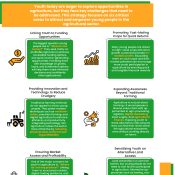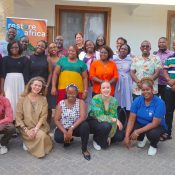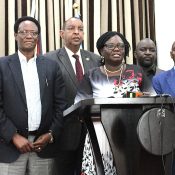
How a Citrus farmer views trees as an investment for his golden years
“Over ten years ago, our area boasted numerous trees of different species. Most of them were mature, which is a stark contrast to the young trees and sparse tree coverage we see today,” says John Mutuku, a farmer from Pongwe Kikoneni Ward in Lunga Lunga Sub-County, Kwale County.
At 59 years old, John, who was born and raised in Pongwe Kikoneni, is well aware of the adverse effects of deforestation on the region. “Trees with large trunks have become rare,” he reflects nostalgically on his earlier years. As a lead farmer, John is hosting a demonstration farm where the Global EverGreening Alliance’s Restore Africa Programme implementing partner, Africa Harvest, supported in planting 50 citrus trees including Valencia, Pixie, and Ponkan varieties. This farm will serve as a model for other farmer groups and community members in the area.
Joining him in the tree-planting activity were his wife, Nazua Mtenzi, and a few farmhands. Nazua is excited that their farm will be used to teach other farmers about good agricultural practices in citrus cultivation. She also grows indigenous vegetables and passion fruits, among other crops, and was eager to participate in the tree-planting effort.
“We were informed that we can still plant other crops around the citrus trees to make the most of our space,” says John. Farmers are interested in planting trees but worry that these trees will compete with their priority crops for space. “Most farmers work on inherited land, which has been subdivided into small parcels. Consequently, many have limited land, and they must prioritise various value chains,” he explains. The farmers I have spoken with have expressed concern that trees take up significant space on their farms, but I have encouraged them since the trees implemented in the Restore Africa programme are also income generating.” John adds.
However, John is optimistic. “When the trees mature, we will have plenty of fruits to harvest and sell, generating an income.” He has another reason for his enthusiasm about planting trees: “My children are currently in secondary school, and in a few years, they will be leaving home, which means my wife and I will become empty nesters,” he chuckles. He further states, “Trees are an investment for me since they require minimal labor. As I age, I realise I don’t have much strength left for tilling the land. I want to make my life easier in the future. The trees I have on my farm can sustain my wife and I in our golden years.”
John is also grateful for the trust his community has placed in him, and he looks forward to training his group, Mwabadari Maendeleo Group B, which consists of 11 members, seven of whom are female, in good agricultural practices for citrus cultivation. Nazua is confident that, “As we continue to plant more trees, we won’t be affected by the drought that affected us this year in the future.”
Eliud Mutahi, Program Manager for Africa Harvest under the Restore Africa Programme, expresses confidence in the citrus value chain selected by stakeholders in Kwale County. “The citrus value chain will support land restoration, generate income for farmers, and strengthen market linkages since group entry into the market is much easier and more effective than individual efforts,” he explains.
“I am pleased with the progress we are making in this project. Now it is my responsibility to arrange field days on this farm where farmers can learn and share knowledge. I also plan to encourage our farmers to actively participate in managing the demonstration plot,” says Yusuf Kiponda, the County Implementing Officer for Africa Harvest.
Smallholder farmers like John and Nazua are contributing to an initiative to plant 3.5 million trees in Kwale County, enhancing reforestation efforts and boosting agricultural productivity. Led by the Global EverGreening Alliance, the Restore Africa Programme is a farmer-driven initiative to combat climate change by restoring degraded landscapes across six countries in East and Southern Africa: Ethiopia, Kenya, Malawi, Tanzania, Uganda and Zambia.
The program integrates carbon sequestration, biodiversity restoration and sustainable farming practices, with a strong emphasis on community participation and Farmer Managed Natural Regeneration (FMNR). It also aims to sequester over 11 million tons of carbon, significantly contributing to mitigating the impacts of climate change.
Global Evergreening Alliance originally published this story on 13th February 2025



